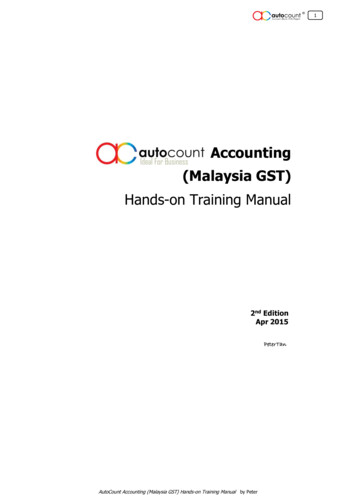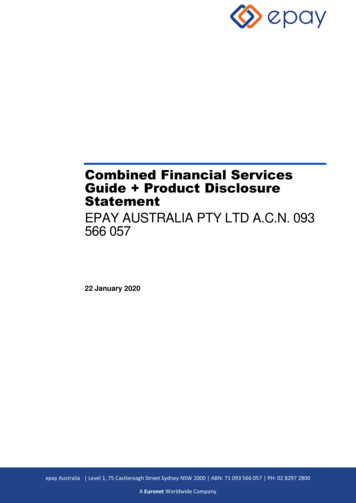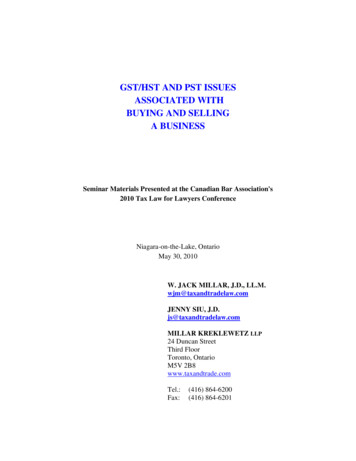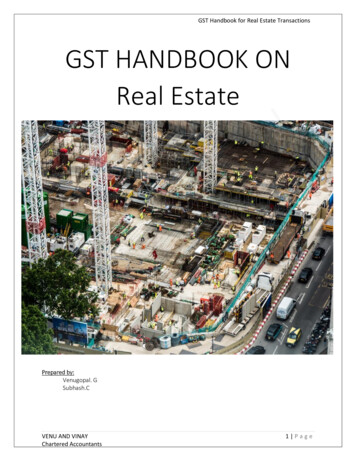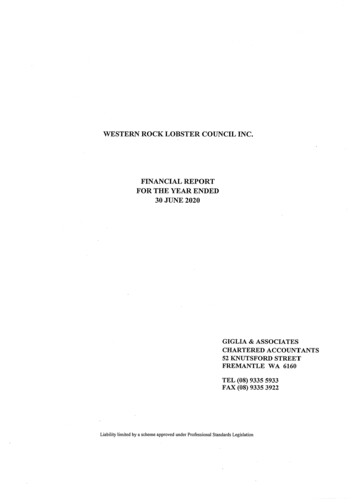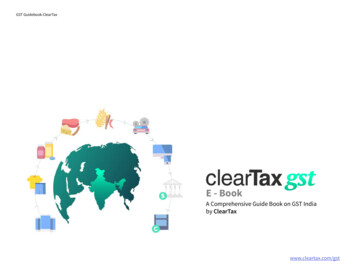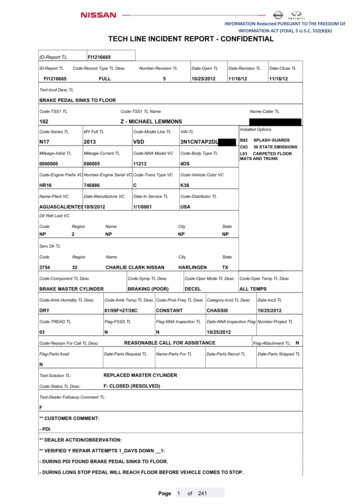
Transcription
Course InformationCourse Code:GST 107Course Title:Credit Unit:Course Status:Semester:Required Study Hour:Course Edition:A Study Guide for the Distance Learner2Compulsory1st4 hours per weekFirstCourse TeamCourse Developers:Course Writers:Instructional Designer:Learning Technologists:Content EditorCopy Editors:Prof. Olubiyi Adewale, Dr. Johnson Opateye,Dr. Chidinma Onwubere, & Miss Nora OnwumeluProf. Olubiyi Adewale, Dr. Johnson Opateye,Dr. Chidinma Onwubere, & Miss Nora OnwumeluInegbedion, Juliet O. (Ph.D.)Dr. Adewale Adesina, Nura Maidoki & Henry UdehInegbedion, Juliet O. (Ph.D.)Inegbedion, Juliet O. (Ph.D.) & Mrs. ChristianaUzoukwuIce BreakerUpload your passport and introduce yourself by stating your names, what youdo for a living, your hobby, your expectation in this course and the name youwould preferred to be called during this course.NATIONAL OPEN UNIVERSITY OF NIGERIA1
2018 by NOUN PressNational Open University of NigeriaHeadquartersUniversity VillagePlot 91, Cadastral ZoneNnamdi Azikiwe ExpresswayJabi, AbujaLagos Office14/16 Ahmadu Bello WayVictoria Island, Lagose-mail: centralinfo@nou.edu.ngURL: www.nou.edu.ngAll rights reserved. No part of this book may be reproduced, in anyform or by any means, without permission in writing from the publisher.Published by:National Open University of NigeriaHeadquarters, University VillagePlot 91, Cadastral Zone, Nnamdi Azikiwe ExpresswayJabi, Abuja, NigeriaPrinted by NOUN Pressnp@noun.edu.ngPrinted 2018ISBN: 978-978-8521-90-72
Course GuideIntroductionWelcome to GST 107: A Study Guide for the Distance Learner. GST 107 isa two-credit unit course that has minimum duration of one semester. It is acompulsory course for both undergraduate and graduate students in theuniversity. The course guides you on the techniques of studying to achieveacademic success through open and distance learning.Course ObjectivesBy the end of this course you will be able to:1. Study on your own at your pace and time irrespective of thegeographical difference2. Identify studying techniques to adopt towards achieving academicsuccess3. Demonstrate the skills required of a distance learner in achievingacademic excellence.Working through this CourseTo successfully complete this course, read the study units, listen to the audiosand videos, do all assessments, open the links and read, participate indiscussion forums, read the recommended books and other materialsprovided, prepare your portfolios, and participate in the online facilitation.Each study unit has introduction, intended learning outcomes, the maincontent, conclusion, summary and references/further readings.Theintroduction will tell you the expectations in the study unit. Read and note theintended learning outcomes (ILOs). The intended learning outcomes tell youwhat you should be able to do at the completion of each study unit. So, youcan evaluate your learning at the end of each unit to ensure you haveachieved the intended learning outcomes. To meet the intended learningoutcomes, knowledge is presented in texts, video and links arranged intomodules and units. Click on the links as may be directed but where you arereading the text off line, you will have to copy and paste the link address into abrowser. You can download the audios and videos to view off line. You canalso print or download the texts and save in your computer or external drive.The conclusion gives you the theme of the knowledge you are taking awayfrom the unit. Unit summaries are presented in downloadable audios andvideos.There are two main forms of assessments – the formative and the summative.The formative assessments will help you monitor your learning. This ispresented as in-text questions, discussion forums and Self-AssessmentExercises.3
The summative assessments would be used by the university to evaluate youracademic performance. This will be given as Computer Based Test (CBT)which serves as continuous assessment and final examinations. A minimumof three computer based tests will be given with only one final examination atthe end of the semester. You are required to take all the computer base testsand the final examination.Study UnitsThere are 16 study units in this course divided into four modules.modules and units are presented as follows:Module 1Unit 1Unit 2Unit 3TheIntroduction to the Open and Distance Learning (ODL)SystemHistory of the Open and Distance Learning SystemCharacteristics of the Open and Distance Learning SystemTeaching and Learning in the Open and Distance LearningSystemModule 2Unit 1Unit 2Unit 3Unit 4Unit 5Study Skills for the Distance LearnerListeningSpeakingReadingWritingStudy StrategiesModule 3Unit 1Unit 2Unit 3Unit 4Assessment and Evaluation Modes in Open And DistanceLearning (ODL)Overview of Assessment in ODLInstructional-Based Assessment ModesSemester ExaminationAssessment of Non-Examinable CoursesModule 4Unit 1Unit 2Unit 3Unit 4Learners’ Support ServicesDefinition and Purposes of Learners’ Support ServicesTypes of Learners’ Support ServicesSources of Learners’ Support ServicesBenefits of Learners’ Support ServicesReferences and Further ReadingsUsun, Salih (2004). Learner Support Services in Distance Education System.Turkish Online Journal of Distance Education, 5 (4), np.Chatpakkarattana, T. & Jintawee Khlaisang. (2012). The Learner SupportSystem for Distance Education. Creative Education, 3, p. /2263/24076/Complete.pdf?4
/StudentSupport/Student Support Services for Success in OEDSIMPSON.pdfAjadi, T. O., Salawu, I. O. & Adeoye, F. A. (2008). E-learning and distanceeducation in Nigeria. The Turkish Online Journal of Educational Technology, 7(4) available at ede, Oluwagbemiro (2016). Open and distance learning practices inNigeria higher institutions of learning. A paper presented at the AnnualDistance Learning Centre Distinguished Lecture and Stakeholders’ ForumHeld at the International Conference Centre, University of Ibadan. Available atwww.olugbemirojegede.com/odl practices in tertiary institutions in nigeria.pdfConrad, D., Mackintosh, W., McGreal, R., Murphy, A. & Witthaus, G. (2013).Report on the assessment and accreditation of learners using OER. Retrieved14 February 2018 from http://oasis.col.org/handle/11599/232Jheengut, I. (2010). Importance of interactivity in open and distance learningcontinuous professional development courses, available inhttp://oasis.col.org/handle/11599/2257Mishra, S. (2017). Media and technology in distance education, available nit-5.pdfPresentation ScheduleThe presentation schedule gives you the important dates for the completion ofyour computer-based tests, participation in forum discussions andparticipation at facilitation. Remember, you are to submit all your assignmentsat the appropriate time. You should guide against delays and plagiarisms inyour work. Plagiarism is a criminal offence in academics and is highlypenalized.AssessmentThere are two main forms of assessments in this course that will be scored:the Continuous Assessments and the final examination. The continuousassessment shall be in three fold. There will be two Computer BasedAssessment.The computer-based assessments will be given inaccordance to university academic calendar. The timing must be strictlyadhered to. The Computer Based Assessments shall be scored a maximumof 10% each, while your participation in discussion forums and your portfoliopresentation shall be scored maximum of 10% if you meet 75% participation.Therefore, the maximum score for continuous assessment shall be 30%which shall form part of the final grade.5
The final examination for GST 107 will be maximum of two hours and it takes70 percent of the total course grade. The examination will consist of 70multiple choice questions that reflect cognitive reasoning.Note: You will earn 10% score if you meet a minimum of 75% participation inthe course forum discussions and in your portfolios otherwise you will lose the10% in your total score. You will be required to upload your portfolio usingGoogle Doc. What are you expected to do in your portfolio? Your portfolioshould be note or jottings you made on each study unit and activities. Thiswill include the time you spent on each unit or activity.How to get the Most from the CourseTo get the most in this course, you need to have a personal laptop andinternet facility. This will give you adequate opportunity to learn anywhere youare in the world. Use the Intended Learning Outcomes (ILOs) to guide yourself-study in the course. At the end of every unit, examine yourself with theILOs and see if you have achieved what you need to achieve.Carefully work through each unit and make your notes. Join the online realtime facilitation as scheduled. Where you missed the scheduled online realtime facilitation, go through the recorded facilitation session at your own freetime. Each real time facilitation session will be video recorded and posted onthe platform.In addition to the real time facilitation, watch the video and audio recordedsummary in each unit. The video/audio summaries are directed to salient partin each unit. You can assess the audio and videos by clicking on the links inthe text or through the course page.Work through all self-assessment exercises. Finally, obey the rules in theclass.FacilitationYou will receive online facilitation. The facilitation is learner centred. Themode of facilitation shall be asynchronous and synchronous. For theasynchronous facilitation, your facilitator will: Present the theme for the week; Direct and summarise forum discussions; Coordinate activities in the platform; Score and grade activities when need be; Upload scores into the university recommended platform; Support you to learn. In this regard personal mails may be sent; Send you videos and audio lectures; and podcast.6
For the synchronous: There will be eight hours of online real time contact in the course. Thiswill be through video conferencing in the Learning ManagementSystem. The eight hours shall be of one-hour contact for eight times. At the end of each one-hour video conferencing, the video will beuploaded for view at your pace. The facilitator will concentrate on main themes that are must know inthe course. The facilitator is to present the online real time video facilitation timetable at the beginning of the course. The facilitator will take you through the course guide in the first lectureat the start date of facilitationDo not hesitate to contact your facilitator. Contact your facilitator if you: do not understand any part of the study units or the assignment.have difficulty with the self-assessment exerciseshave a question or problem with an assignment or with your tutor’scomments on an assignment.Also, use the contact provided for technical support.Read all the comments and notes of your facilitator especially on yourassignments; participate in the forums and discussions. This gives youopportunity to socialise with others in the programme. You can raise anyproblem encountered during your study. To gain the maximum benefit fromcourse facilitation, prepare a list of questions before the discussion session.You will learn a lot from participating actively in the discussions.Finally, respond to the questionnaire. This will help the university to knowyour areas of challenges and how to improve on them for the review of thecourse materials and lectures.7
CONTENTSModule 1Introduction to the Open and DistanceLearning (ODL) System9Unit 1Unit 2Unit 3History of the Open and Distance Learning System9Characteristics of the Open and Distance Learning System 18Teaching and Learning in the Open and DistanceLearning System27Module 2Unit 1Unit 2Unit 3Unit 4Unit 5Study Skills for the Distance LearnerListeningSpeakingReadingWritingStudy StrategiesModule 3Unit 1Unit 2Unit 3Unit 4Assessment and Evaluation Modes in Openand Distance Learning (ODL)Overview of Assessment in ODLInstructional-Based Assessment ModesSemester ExaminationAssessment of Non-Examinable Courses88889598102Module 4Unit 1Unit 2Unit 3Unit 4Learners’ Support ServicesDefinition and Purposes of Learners’ Support ServicesTypes of Learners’ Support ServicesSources of Learners’ Support ServicesBenefits of Learners’ Support Services1141141181221303636455163758
Module 1Introduction to the Open and Distance Learning(ODL) SystemUnit 1Unit 2Unit 3History of the Open and Distance Learning SystemCharacteristics of the Open and Distance Learning SystemTeaching and Learning in the Open and Distance LearningSystemUnit 1History of the Open and Distance Learning SystemContents1.0Introduction2.0Intended Learning Outcomes (ILOs)3.0Main Content3.1Definition of Open and Distance Learning3.2History of Open and Distance Learning3.2.1 The Distance Learning3.2.2 Open and Distance Learning3.3Open and Distance Learning in r Reading1.0IntroductionAs a student of an open university, it is important for you to have a fair idea ofthe system you are getting involved in. This is because you might not havehad the opportunity of studying in an open university before now and yoursuccess in this system is heavily dependent on your understanding of theworkings of this system. Thus, it is important for you to pay close attention tothis course as it would help you to understand the demands of the open anddistance learning. In this first unit, you will be go through a brief history of theopen and distance learning system both globally and also in Nigeria.2.0Intended Learning Outcomes (ILOs)By the end of this unit, you will be able to: define open and distance learning identify the various stages of distance education differentiate between distance learning and open learning comment on the role of technology in distance learning.9
3.0Main Content3.1Definition of Open and Distance LearningThe term open and distance learning is made up of two different concepts ineducation, namely: distance education and open learning. While distanceeducation has been around for quite a long time (as you would soondiscover), open learning is a more recent phenomenon. You have tounderstand that there has been no consensus definition of the twin term, butfor the purpose of this course, we will make do with the definition fromCommonwealth of Learning (COL). COL (2015) defines open and distancelearning as a system of teaching and learning characterized by separation ofteacher and learner in time and/or space and uses multiple media for deliveryof instruction. It also involves two-way communication and occasional face-toface meeting for tutorials and learner-to-learner interaction. As you would getto know, this definition has tried to bring all the attributes of the open anddistance learning to the fore.3.2History of Open and Distance LearningAs stated earlier, the term open and distance learning combines two distinctterms: distance education and open learning. While distance education is nota new concept and thus familiar to most people, open learning is relatively anewer term. In fact, distance education can be said to be the forerunner ofopen and distance learning, thus a good starting point for the history of openand distance learning is distance education.3.2.1 The Distance EducationDistance education has been defined as a field of education that focuses onteaching methods and technology with the aim of delivering teaching tostudents who are not physically present in a traditional educational setting,such as the classroom. It is a system aimed at creating access to learningwhen time or distance or both separate the source of information and thelearners.Though the various developmental stages of distance education have beenvariously demarcated to be from three to five, I prefer the three-stagedevelopment propounded by Schultz, Schultz and Embry-Riddle (2008) and itwould be followed in our history of distance education.3.2.1.1Correspondence StageThe earliest appearance of distance education was in the form ofcorrespondence education. This started in the mid-nineteenth century in GreatBritain, France, Germany and the United States. Describing thecorrespondence phase, Schultz, Schultz and Embry-Riddle (2008) state that,“early correspondence courses, as the first recorded form of distancelearning, exemplified participant interaction through the distribution of printedmaterial through the mail” (p. 23). Sir Isaac Pitman taught shorthand by mail10
and this can be said to be the first officially recognized attempt at distanceeducation. Pitman’s Correspondence courses in shorthand started in the1840s.At the degree level, the University of London was the first to offer degreesthrough distance education. The University of London’s External Programmewas established in 1828 but was not chartered until 1858. It is important tonote that most of the students of the programme were from the BritishCommonwealth countries including Nigeria. In the United States,“correspondence study has been a noteworthy component of the University ofWisconsin delivery system since 1891” (Schultz, Schultz and Embry-Riddle,2008).3.2.1.2Sound and Video Signal StageThe foundation of the second stage of distance education was laid during theWorld War I, through the invention of the radio. In the United Kingdom, theNational University Extension Association was organized in 1916 at theUniversity of Wisconsin. The first educational instruction by radio was aired in1916 and from that point; correspondence students began receivinginstruction from both radio and postal services. It was not until 1925 that theuse of radio in distance education became global (History of DistanceEducation, 95). The United States started the experimental radio broadcastwith the College of the Air which was later renamed the University of the Air inconjunction with the University of Wisconsin in the early 1960s. By the end ofthe decade, 200 faculties were participating in various short courses (Gooch,1968).Figure 1: A student learning through the Radio (Source: Google Images)The use of the radio was followed by the use of the television. The televisionexperiment began in 1874 but educational television did not start until after11
the depression when State University of Iowa and Kansas State Collegeproduced some educational programmes between 1932 and 1934. However,after permission was granted many colleges and universities followed suit.Demiray and Isman (1999) state that “in today’s USA, commercial and publictelevision stations produced educational programmes for distance education.29 million students are able to receive these programmes at their homes orschool” (p. 96).3.2.1.3Computer Technology StageComputer technology represented the third phase of distance education.Commenting on this phase, Schultz, Schultz and Embry-Riddle (2008) saidthat, “the new 80s space-age brought technology which included computersand space satellites, thereby allowing universities to offer adult educationprograms and refresher courses to students situated thousands of miles fromthe actual campuses” (p. 24). It is important to note the continuousdevelopment of technology continues to affect educational delivery from thistime onwards. We would not comment much on this as the use computertechnology and information technology is an integral part of open learning andwould form part of our studies in future units.3.2.2 Open and Distance LearningOpen learning is an innovative movement in education that emerged in the1970s. It refers mainly to activities that either enhance learning opportunitieswithin formal education systems or broaden learning opportunities beyond theformal education systems (Wikipedia). The educational philosophy of openlearning emphasizes giving learners choices about: medium or media oflearning, place and pace of study, support mechanisms as well as entry andexit points. The combination of the philosophy of open learning and distanceeducation gave birth to open and distance learning. Open and distancelearning is one of the most rapidly growing fields of education and its potentialimpact in all educational delivery has been greatly accentuated through thedevelopment of Internet-based information technologies, and in particular theWorld Wide Web (UNESCO, 2002).The first Open University, The Open University, was established in 1969 as apublic distance learning and research university and it’s one the biggestuniversity in United Kingdom. Since this humble beginning, many other openuniversities have sprung up in the various regions of the world. The currenttrend in open universities is the movement towards internationalization. Inaddition to the political and economic driving forces, the internationalization ofopen and distance education is enhanced by its links to information andcommunication technologies (ICTs). For instance, educational software isoften international, and satellites and electronic networks allow transmissionand communication across national borders. The global classroom is nolonger a concept only of our imagination or of the future (UNESCO, 2002).12
The success of the United Kingdom Open University led to the establishmentof other open universities around the world. Jegede (2016) states that theseinclude Athabasca University, and Canada’s Open University that werecreated in 1970 and were followed by Spain’s National University of DistanceEducation in 1972 and Germany’s Fern Universität in Hagen in 1974. Thesuccess of the open and distance learning system in Asia cannot beoverlooked. In fact most successful open universities in the world today are inAsia. For example, there are 41 open and distance learning tertiaryinstitutions in Asia out of which only 5 are private institutions. The privateinstitutions are: Arab Open University, Open University of Malaysia, the OpenUniversity of Japan, Venkateshwara Open University and Wawasan OpenUniversity. It is worthy of note that out of these 41 universities, 17 are cited inIndia.3.3Open and Distance Learning in NigeriaIt is important to note that the development of the open and distance learningin Nigeria is rooted in a policy. The 1977 National Policy on Education (NPE)has anticipated the coming of open and distance learning. The 1977 edition ofthe NPE states: “maximum efforts will be made to enable those who canbenefit from higher education to be given access to it. Such access may bethrough universities or correspondence courses, or open universities, or parttime and work study programme”. It is unknown however if this was as aresult of the role of distance education in the lives of some early Nigerians.As in all countries with distance education history, Nigeria also had her fairshare of correspondence education. As Jegede (2016) notes:a. The Oxford University of the United Kingdom’s extra mural studies atthe University College, Ibadan, which commenced in 1947 enabled agood number of Nigerians thirsty for higher education, but who areunable to get a place in the limited admissions into the UniversityCollege, Ibadan, to do so through correspondence study.b. Many Nigerians sought admission as students of CorrespondenceCollege in Universities and Institutions in the United Kingdom whileothers registered as external candidates for the General Certificate ofEducation (GCE) both Ordinary and Advanced Level of the Universityof London and Cambridge.c. The Rapid Results College and Wosley Hall correspondence studiesmay be cited as the first set of ‘organised’ Distance LearningProgrammes in Africa. They are termed ‘correspondence’ becausethey had their studies mailed from England while the students equallymailed their answers overseas to be marked.Nigeria also had her fair share of the radio/television stage of distanceeducation through the English by Radio programme of the NigerianBroadcasting Corporation (NBC) in 1960. The Educational Television13
Programme of the National Television of Nigeria then followed the NBC 1960initiative.The open and distance learning mode was first employed at the tertiary levelby Ahmadu Bello University when it established the University of the Air in1972 and this was used for the Teachers In-Service Educational Programmein 1975. The University of Lagos followed the Ahmadu Bello University’sinitiative in 1974 by establishing Correspondence and Open Studies Unit(COSU) that later became known as Correspondence and Open StudiesInstitute (COSIT) and now known as Distance Learning Institute (DLI). Withthis act, University of Lagos became the first Nigerian tertiary institution tooperate the dual mode of the open and distance learning.The decision to set up an open university in Nigeria was first conceived in1976. To put this decision into practice, the Federal Government set up aPresidential Planning Committee under the chairmanship of Professor AfolabiOjo to advise the government on the initiative. This committee wasinaugurated on May 1 1980. The Act to back up the establishment of theOpen University was passed by the National Assembly on April 20 1983. Todemonstrate the seriousness of the Federal Government, after three months,precisely on July 22 1983, the then President of Nigeria, Alhaji Shehu Shagariassented to the bill as passed. This led to the establishment of the NigeriaOpen University (NOU) with Professor Afolabi Ojo as its Vice-Chancellor. By1984, NOU went into full-scale activities of screening candidates in 1984.Unfortunately, on April 25, 1984, General Muhammad Buhari, who hadbecome the Head of State of Nigeria, after the civilian government have beentoppled in a coup d’état, suspended the NOU during a budget speech.Consequently, Nigeria had lost several years of the use and practice of openand distance learning (Jegede, 2016).However, in 2002, a new Open University, with the name, National OpenUniversity of Nigeria (NOUN) was established during the tenure of anothercivilian president, Chief Olusegun Obasanjo. It has to be on record that ChiefObasanjo not only established the NOUN, he demonstrated the relevance ofthe university by enrolling as a student of the university immediately he leftoffice as the President. Chief Olusegun Obasanjo started with the PostGraduate Diploma in Christian Theology after which he went ahead to theMasters’ Degree and capped it up with a Doctor of Philosophy degree. Today,Chief Olusegun Obasanjo has made history by becoming the first doctoralgraduate of Christian Theology and of NOUN.It is important to note that after the establishment of NOUN, Commonwealthof Learning (COL) partnered with the university to establish the RegionalTraining and Research Institute for Open and Distance Learning (RETRIDAL)in 2003. RETRIDAL was established with the aim of identifying and meetingthe needs of open and distance learning related research and capacitybuilding for the West African sub-region.Currently, Nigeria has many dual mode open and distance learninginstitutions as Jegede (2016) states that “institutions of higher learning that14
now have or are working on becoming dual mode systems to use both openand distance learning and the traditional face-to-face as institutional modes”are 20. However, National Open University of Nigeria is the only mono-modeopen and distance learning university in Nigeria as of today.3.3.1 The Need for Open and Distance Learning System in NigeriaAs a result of the feelings in some quarters about the necessity of an openuniversity in Nigeria, it is important to state the reasons for the establishmentof the university.3.3.1.1The Carrying Capacity of the Conventional UniversitiesThe continued increase in the population of Nigerians demanding universityeducation in the last decade revealed that Nigeria has more universityapplicants unabsorbed than those admitted despite the increase in thenumber of universities in the country. Umar (2006) opines that about 80% ofqualified prospective students could not gain admission into the conventionaluniversities. To support this position, the table below gives a graphic depictionof the situation.Table 1: Admission Statistics of Nigerian StudentsYear Number of Number of Number%Universities Applicants AdmittedAdmitted2008 941,054,053118,69111.32009 961,306,005190,78614.52010 1021,404,111192,25513.72011 1121,493,611450,00030.132012 1171,503,933500,00033.252013 1281,735,729520,00029.962014 1291,015,504550,000542015 1411,475,477600,00040.72016 1471,272,284700,000552017 477572,284986,571The table above provides the stark reality of the Nigerian higher educationsituation. Considering the role and importance of education in a developingcountry, this is a dangerous trend. If necessary steps were not taken toaddress this trend, by democratising education through the use of open anddistance learning, the population of Nigerians without higher education wouldcontinue to soar and realization of any millennium developmental goal inNigeria would be a mirage.3.3.1.2Continuous Demand for Higher EducationIn the last few decades, there has been a continuous demand for highereducation by the employers of labour for promotion and also assessment15
purposes that has thrown the employees into a kind of frenzy to acquirehigher education. This demand for higher educational qualification byemployees coupled with the recent high rate of unemployment in the countryhas made the open and distance learning system the best viable option. Thisis because those who are expected to improve their educational status couldnot risk resigning or embarking on study leave (which are rarely approved)because they are not sure they would have their job back on completion ofhigher educational status.We can use the educational requirement to teach in Nigeria as an examplehere. Someti
Course Guide Introduction Welcome to GST 107: A Study Guide for the Distance Learner . GST 107 is a two-credit unit course that has minimum duration of one semester. It is a compulsory course for both undergraduate and graduate students in the university. The course guides you on the techniques of studying to achieve
